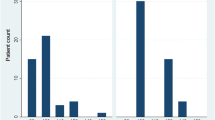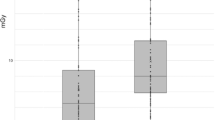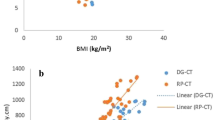Abstract
Background and objective
To study the radiation dose and image quality on the use of full-field organ dose modulation (ODM) on cervical-thoracic-abdominal-pelvic contrast-enhanced computed tomography (CT) scanning on female chemotherapy patients.
Methods
Eighty female chemotherapy patients undergoing cervical-thoracic-abdominal-pelvic contrast-enhanced CT were prospectively enrolled and randomly divided into two groups: group A and group B, each with 40 patients. Full-field ODM technique was used on group A and regular scanning patterns were used on group B. We calculated and recorded the signal-to-noise ratio (SNR), contrast-to-noise ratio (CNR), subjective scores, mean tube currents of the anterior, left, posterior, and right aspects of the thyroid, breast, and ovary layers of all the images. The CT dose index volume (CTDIvol) and dose-length product (DLP) of each patient were recorded and the effective radiation dose (ED) was calculated. The above data were statistically analyzed.
Results
There were no statistically significant differences in the SNR, CNR, and image quality scores of the thyroid, breast, and ovary layers of groups A and B during the arterial and venous phases (P > 0.05). The tube current on the anterior, left, posterior, and right aspects of the thyroid, breast, and ovary layers during the arterial and venous phases (thyroid: 324.46 ± 53.2 and 327.97 ± 61.34; breast: 243.13 ± 50.04 and 248.32 ± 60.33; ovary: 332.28 ± 71.50 and 339.78 ± 76.69; respectively) of group A were (statistically) significantly lower than those of group B (thyroid: 407.60 ± 96.81 and 402.73 ± 90.15; breast: 313.00 ± 106.68 and 315.20 ± 106.73; ovary: 457.78 ± 106.56 and 459.63 ± 106.27; respectively) (P < 0.05). The respective mean CTDIvol and DLP in group A were 22% and 24% lower than those of group B. The mean EDs of the neck, chest, and abdominal-pelvic region in group A were 19.3%, 21.4%, and 26.4% lower than those of group B, respectively (P < 0.05).
Conclusion
The use of ODM can reduce radiation dose of female chemotherapy patients undergoing cervical-thoracic-abdominal-pelvic contrast-enhanced CT, especially radiation-sensitive organs, while maintaining overall image quality.


Similar content being viewed by others
References
Wang N, Wang X, Li W, Ye H, Bai H, Wu J, et al. Contrast-enhanced CT parameters of gastric adenocarcinoma: can radiomic features be surrogate biomarkers for HER2 over-expression status? [J]. Cancer Manag Res. 2020;12(1):1211–9.
Wang M, Ma X. Texture analysis in contrast enhanced CT: New method to predict prognosis of small cell lung cancer treated with platinum-based chemotherapy [J]. Ann Oncol. 2019;1(1):10.
Li CF, Zheng J, Xue YW. The value of contrast-enhanced computed tomography in predicting gastric cancer recurrence and metastasis [J]. Cancer Biomark. 2017;19(3):327–33.
Park CJ, Kim KW, Lee HJ, Kim MJ, Kim J. Contrast-enhanced CT with knowledge-based iterative model reconstruction for the evaluation of parotid gland tumors: a feasibility study [J]. Korean J Radiol. 2018;19(5):957–64.
Qiao PG, Zhang HT, Zhou J, Li M, Ma JL, Tian N, et al. Early evaluation of targeted therapy effectiveness in non-small cell lung cancer by dynamic contrast-enhanced CT [J]. ClinTranslOncol. 2016;18(1):47–57.
Lee HS, Suh YJ, Han K, Kim JY, Chang S, Im DJ, et al. Effectiveness of automatic tube potential selection with tube current modulation in coronary CT angiography for obese patients: Comparison with a body mass index-based protocol using the propensity score matching method [J]. PLoS ONE. 2018;13(1):e0190584.
Zhu X, Shi Z, Zhu Y, Liu W, Yang G, Yu T, et al. Individually adapted tube current selection and contrast medium injection protocol of coronary CT angiography based on test bolus parameters: a feasibility study [J]. ActaRadiol. 2015;56(6):666–72.
Tian X, Sun C, Liu Z, Li W, Duan H, Wang L, et al. Prediction of response to preoperative neoadjuvant chemotherapy in locally advanced cervical cancer using multicenter CT-based radiomic analysis [J]. Front Oncol. 2020;10(2):77.
Jordan DW, Becker MD, Brady S, Keenan MA, Rosen MP, Sengupta D, et al. Validation of adult relative radiation levels using the ACR dose index registry: report of the ACR appropriateness criteria radiation exposure subcommittee [J]. J Am CollRadiol. 2019;16(2):236–9.
Mathews JD, Forsythe AV, Brady Z, Butler MW, Goergen SK, Byrnes GB, et al. Cancer risk in 680,000 people exposed to computed tomography scans in childhood or adolescence: data linkage study of 11 million Australians [J]. BMJ. 2013;346(2):f2360.
Cohen MD. ALARA, image gently and CT-induced cancer [J]. PediatrRadiol. 2015;45(4):465–70.
Lahham A, Kameel S. Estimation of female radiation doses and breast cancer risk from chest ct examinations [J]. RadiatProt Dos. 2018;179(4):303–9.
Papadakis AE, Damilakis J. Automatic tube current modulation and tube voltage selection in pediatric computed tomography: a phantom study on radiation dose and image quality [J]. Invest Radiol. 2019;54(5):265–72.
Rusandu A, Odegard A, Engh GC, Olerud HM. The use of 80 kV versus 100 kV in pulmonary CT angiography: An evaluation of the impact on radiation dose and image quality on two CT scanners [J]. Radiography (Lond). 2019;25(1):58–64.
You SK, Choi YH, Cheon JE, Kim WS, Kim IO, Lee SM, et al. Effect of low tube voltage and low iodine concentration abdominal CT on image quality and radiation dose in children: preliminary study [J]. AbdomRadiol (NY). 2019;44(5):1928–35.
Raudabaugh J, Smith AK, Moore B, Ramirez-Giraldo JC, Januzis N, Yoshizumi T. Evaluating lens dose reduction in pediatric neuroradiology examinations using automated kilovoltage selection software [J]. AJR Am J Roentgenol. 2018;211(3):635–40.
Nijhof WH, Baltussen EJ, Kant IM, Jager GJ, Slump CH, Rutten MJ. Low-dose CT angiography of the abdominal aorta and reduced contrast medium volume: assessment of image quality and radiation dose [J]. ClinRadiol. 2016;71(1):64–73.
Mehnati P, Malekzadeh R, Sooteh MY. Use of bismuth shield for protection of superficial radiosensitive organs in patients undergoing computed tomography: a literature review and meta-analysis [J]. RadiolPhysTechnol. 2019;12(1):6–25.
Mangold S, Wichmann JL, Schoepf UJ, Poole ZB, Canstein C, Varga-Szemes A, et al. Automated tube voltage selection for radiation dose and contrast medium reduction at coronary CT angiography using 3(rd) generation dual-source CT [J]. EurRadiol. 2016;26(10):3608–16.
Mangold S, De Cecco CN, Wichmann JL, Canstein C, Varga-Szemes A, Caruso D, et al. Effect of automated tube voltage selection, integrated circuit detector and advanced iterative reconstruction on radiation dose and image quality of 3rd generation dual-source aortic CT angiography: an intra-individual comparison [J]. Eur J Radiol. 2016;85(5):972–8.
Li W, Zhang CQ, Li AY, Deng K, Shi H. Preliminary study of dose reduction and image quality of adult pelvic low-dose CT scan with adaptive statistical iterative reconstruction [J]. ActaRadiol. 2015;56(10):1222–9.
Zhao Y, Xu Y, Bao Y, Geng X, Zhang T, Li D. Comparative analysis of radiation dose and image quality between organ dose modulation and 3D smart mA modulation during head-neck CT angiography [J]. J XraySciTechnol. 2019;27(1):97–110.
Yamauchi-Kawaura C, Yamauchi M, Imai K, Ikeda M, Aoyama T. Image quality and age-specific dose estimation in head and chest CT examinations with organ-based tube-current modulation [J]. RadiatProtDosimetry. 2013;157(2):193–205.
Dixon MT, Loader RJ, Stevens GC, Rowles NP. An evaluation of organ dose modulation on a GE optima CT660-computed tomography scanner [J]. J ApplClin Med Phys. 2016;17(3):380–91.
The Recommendations of the International Commission on Radiological Protection. ICRP publication 103 [J]. Ann ICRP. 2007;37(24):331–2.
Kitera N, Matsubara K, Fujioka C, Yokomachi K, Nishimaru E, Kiguchi M, et al. Organ-based tube-current modulation applied on different MDCT scanners: reduction in the radiation dose to the eye lens at head CT] [J. Nihon HoshasenGijutsuGakkaiZasshi. 2020;76(4):366–74.
Hoang JK, Yoshizumi TT, Choudhury KR, Nguyen GB, Toncheva G, Gafton AR, et al. Organ-based dose current modulation and thyroid shields: techniques of radiation dose reduction for neck CT [J]. AJR Am J Roentgenol. 2012;198(5):1132–8.
Taylor S, Litmanovich DE, Shahrzad M, Bankier AA, Gevenois PA, Tack D. Organ-based tube current modulation: are women’s breasts positioned in the reduced-dose zone? [J]. Radiology. 2015;274(1):260–6.
Euler A, Szucs-Farkas Z, Falkowski AL, Kawel-Bohm N, D’Errico L, Kopp S, et al. Organ-based tube current modulation in a clinical context: dose reduction may be largely overestimated in breast tissue [J]. EurRadiol. 2016;26(8):2656–62.
Funding
This study was funded by Key R&D projects of Hebei Province (grant number: 20377765D), Hebei province program of training and basic project of clinical medicine of China (grant number: 361007), Postgraduate Innovation Project of Hebei University (grant number: hbu2019ss037), and the affiliated hospital of Hebei university outstanding youth foundation (grant numbers: 2015Q002 and 2015Q017).
Author information
Authors and Affiliations
Corresponding author
Ethics declarations
Conflict of interest
We declare that we do not have any commercial or associative interest that represents a conflict of interest in connection with the work submitted.
Human and animal rights
This article does not contain any studies with animals performed by any of the authors.
Ethical approval
All procedures performed in our study involving human participants were in accordance with the ethical standards of the institutional and/or national research committee and with the 1964 Helsinki declaration and its later amendments or comparable ethical standards.
Informed consent
Informed consent was obtained from all individual participants included in the study. All patients signed informed consent. This prospective study received institutional board approval from the affiliated hospital of Hebei University and each participant provided informed consent.
Additional information
Publisher's Note
Springer Nature remains neutral with regard to jurisdictional claims in published maps and institutional affiliations.
About this article
Cite this article
Zhao, Y., Geng, X., Li, D. et al. Application of full-field organ dose modulation on cervical- thoraco-abdominopelvic contrast-enhanced computed tomography. Jpn J Radiol 39, 254–260 (2021). https://doi.org/10.1007/s11604-020-01056-7
Received:
Accepted:
Published:
Issue Date:
DOI: https://doi.org/10.1007/s11604-020-01056-7




